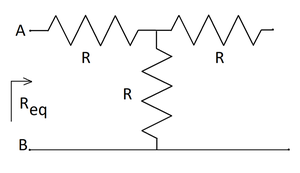An infinite cascade of T-networks

A T -network of three identical resistors, each with a resistance of R , is shown above. What will be the equivalent resistance between points A and B , as we connect an infinite number of these T 's (in cascade) to the right? Enter the limiting ratio of the equivalent resistance to R , i.e. find
R R e q ( ∞ )
The answer is 1.732.
This section requires Javascript.
You are seeing this because something didn't load right. We suggest you, (a) try
refreshing the page, (b) enabling javascript if it is disabled on your browser and,
finally, (c)
loading the
non-javascript version of this page
. We're sorry about the hassle.
2 solutions
@Hosam Hajjir
same my way sir.
Thanks for posting problem..

Let the equivalent resistance of infinite cascade of T -network be R ∞ . From the figure above, we have:
R ∞ R ∞ 2 R R ∞ + R ∞ 2 R ∞ 2 R 2 R ∞ 2 ⟹ R R ∞ = R + R ∣ ∣ ( R + R ∞ ) = R + 2 R + R ∞ R ( R + R ∞ ) = 2 R 2 + R R ∞ + R 2 + R R ∞ = 3 R 2 = 3 = 3 ≈ 1 . 7 3 2 Multiply both sides by 2 R + R ∞
The equivalent resistance is a sequence function of the number n of the cascaded T-networks, R e q = R e q ( n )
We have,
R e q ( 1 ) = 2 R
And iteratively, we can write,
R e q ( n + 1 ) = R + R / / ( R + R e q ( n ) )
= R + ( 2 R + R e q ( n ) ) R ( R + R e q ( n ) )
the fixed point of this recursive equation is obtained by setting R e q ( n + 1 ) = R e q ( n ) = R ∗ , hence
R ∗ = R + ( 2 R + R ∗ ) ( R 2 + R R ∗ )
Multiplying both sides by ( 2 R + R ∗ ) , we get,
2 R R ∗ + R ∗ 2 = R ( 2 R + R ∗ ) + R 2 + R R ∗
re-arranging and simplifying, we obtain,
R ∗ 2 = 3 R 2
so that the limiting R e q is R ∗ = 3 R , therefore, the answer is 3